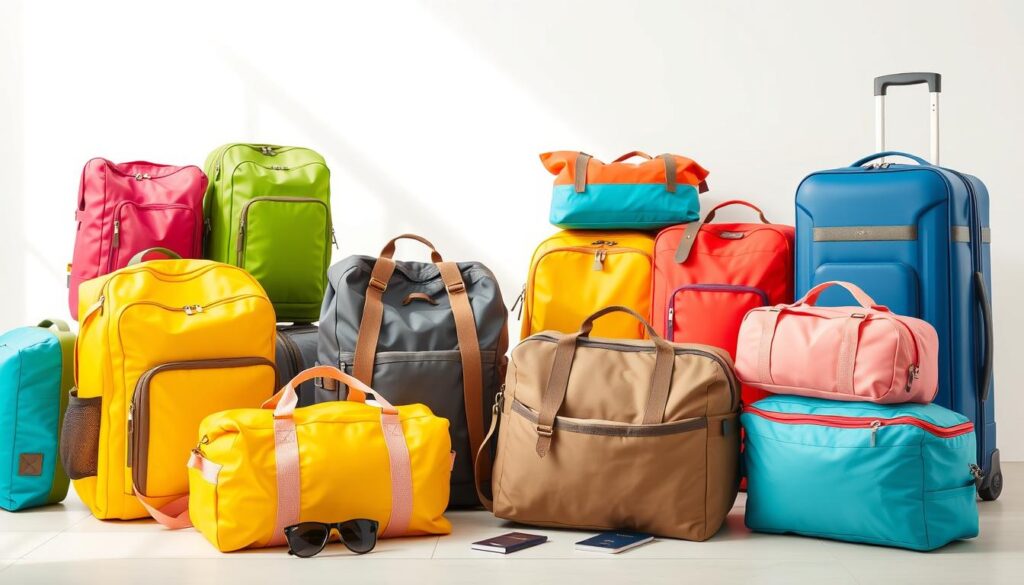Packing for a trip can be tricky, especially with carry-on suitcase weight limits. Airlines have strict rules about how much your bag can weigh. It’s important to know these limits and pack smart. But have you ever thought, “How much does a carry-on suitcase really weigh?”
Key Takeaways
- Airline carry-on weight limits vary, but often range from 7 to 15 pounds.
- Exceeding weight limits can result in hefty fees or your bag being checked at the gate.
- Suitcase material, size, and dimensions all affect the overall weight.
- Choosing the right lightweight carry-on bag is essential for hassle-free travel.
- Understanding TSA-approved suitcase dimensions and packing tips can help you stay within airline restrictions.
This guide will cover everything you need to know about your carry-on suitcase’s weight. We’ll look at airline weight rules and how to pick the right lightweight bag. By the end, you’ll know how to pack smart and follow airline guidelines.
Understanding Carry-On Luggage Weight Restrictions
As a frequent traveler, I’ve learned that knowing the carry-on luggage weight limits is key. Most airlines say your cabin bag can’t be more than 7-22 lbs (3-10 kg). If it’s heavier, you might face extra fees or have your bag checked at the gate. This can be really frustrating.
Airlines’ Carry-On Weight Limits
Carry-on weight limits differ among airlines. Here’s a quick look at some major carriers’ rules:
- American Airlines: 22 lbs (10 kg)
- Delta Air Lines: 15 lbs (7 kg)
- United Airlines: 17 lbs (7.7 kg)
- Southwest Airlines: 10 lbs (4.5 kg)
- JetBlue Airways: 20 lbs (9 kg)
Consequences of Exceeding Weight Limits
Ignoring the weight limits can lead to problems. Airlines might charge you extra, from $25 to $150, to check your bag at the gate. Sometimes, they won’t let it on at all, making you leave it behind or change your packing. To dodge these issues, pack light and make sure your carry-on fits the airline’s weight rule.
| Airline | Carry-On Weight Limit | Excess Baggage Fee |
|---|---|---|
| American Airlines | 22 lbs (10 kg) | $25 – $150 |
| Delta Air Lines | 15 lbs (7 kg) | $25 – $150 |
| United Airlines | 17 lbs (7.7 kg) | $25 – $150 |
| Southwest Airlines | 10 lbs (4.5 kg) | $25 – $150 |
| JetBlue Airways | 20 lbs (9 kg) | $25 – $150 |
Knowing the carry-on weight limits helps you pack smart and avoid extra fees or delays on your trips.
How Much Does a Carry-On Suitcase Weigh?
The average carry-on luggage weight can vary a lot. Most carry-on suitcases are between 4-9 lbs (1.8-4 kg) when empty. But, the total weight depends on what you pack inside.
Let’s look at the typical weight ranges for different carry-on bag materials and sizes:
| Bag Material | Typical Weight Range |
|---|---|
| Hardside Polycarbonate | 5-9 lbs (2.3-4 kg) |
| Softside Nylon/Polyester | 4-7 lbs (1.8-3.2 kg) |
| Aluminum | 6-11 lbs (2.7-5 kg) |
The size of the carry-on also affects its weight. Smaller bags for personal items weigh less, from 3-6 lbs (1.4-2.7 kg). But, bigger carry-ons can be up to 9 lbs (4 kg) or more, depending on the material and features.
When packing your carry-on luggage, watch the total weight. Going over the airline’s limit can lead to extra fees or making you check your bag. Knowing the typical carry-on suitcase weight helps you pack better and avoid unexpected charges on your trip.
Factors Affecting Carry-On Weight
Choosing the right carry-on suitcase is key. You need to think about its material, size, and dimensions. These factors greatly affect how much your bag will weigh, both empty and full.
Suitcase Material
The material of your carry-on suitcase matters a lot for its weight. Light materials like polycarbonate or aluminum make the bag lighter. This helps you stay under the airline’s weight limit. But, heavy materials like hardened plastic or metal can make your bag much heavier, leaving less space for your stuff.
Size and Dimensions
The size and dimensions of your carry-on also affect its weight. Even if a suitcase is made of light materials, a bigger size can make it heavier. It’s important to make sure your carry-on fits the TSA’s size limits. This avoids problems with storing it in the overhead bin and extra fees for heavy or oversized bags.
| Suitcase Material | Typical Empty Weight |
|---|---|
| Polycarbonate | 4-6 lbs |
| Aluminum | 5-8 lbs |
| Hardened Plastic | 6-10 lbs |
| Metal Alloy | 8-12 lbs |
Knowing how the material and size of a suitcase affect its weight helps you choose the best one. This way, you can travel without trouble and follow airline weight rules.
Choosing the Right Carry-On Bag
Choosing the right carry-on bag is key for hassle-free travel. Look for lightweight travel bags made from strong materials like polycarbonate or aluminum. These travel-friendly luggage options help you stay under airline weight limits, making boarding smooth.
Also, think about the bag’s size and dimensions. Make sure it fits the TSA’s guidelines so it slides into the overhead bin easily. This makes your trip more convenient and avoids extra fees or delays due to oversized or heavy luggage.
| Feature | Importance |
|---|---|
| Lightweight Material | Helps you stay within weight limits |
| Compact Size | Fits easily in overhead bins |
| Durable Construction | Protects your belongings during travel |
| Efficient Organization | Keeps your items easily accessible |
When looking for the perfect carry-on, focus on features that make travel better. By picking the right lightweight travel bags and travel-friendly luggage, you’ll have a smooth journey from start to end.

“The right carry-on bag can make all the difference in your travel experience.”
Airline Baggage Allowance: Know Before You Go
Understanding airline baggage rules can seem tough, but it’s key for a smooth trip. Knowing about cabin baggage restrictions and carry-on size limits helps you avoid extra fees. This knowledge is vital for both domestic and international flights.
Domestic vs. International Flights
Domestic and international flights have different baggage rules. Domestic flights usually let you bring more and heavier carry-on bags. But, international flights have stricter rules to meet the needs of travelers worldwide.
| Criteria | Domestic Flights | International Flights |
|---|---|---|
| Carry-On Bag Size | Up to 22 x 14 x 9 inches (55 x 35 x 23 cm) | Up to 21.5 x 13.5 x 9 inches (55 x 35 x 23 cm) |
| Carry-On Weight Limit | 40 lbs (18 kg) | 22 lbs (10 kg) |
| Checked Bag Allowance | 1-2 bags, depending on ticket class | 1-2 bags, depending on ticket class and airline |
Remember, these rules can change between airlines. Always check with your airline before your trip. This way, you can avoid extra fees and delays at the airport.
“Knowing the airline’s carry-on size limits and luggage weight restrictions can save you a lot of hassle and money when traveling.”
Lightweight Travel Bags for Hassle-Free Trips
Packing for a trip can feel overwhelming, but the right carry-on suitcase can change everything. Choosing lightweight travel bags makes going through the airport easier. It also helps you stay under the airline’s weight limits without losing packing space or functionality.
When picking the best travel-friendly luggage, consider a few things. Look for bags made from strong yet light materials like polycarbonate or aluminum. These materials give you the strength you need for your trips without adding too much weight to your bag.
Also, think about the size and dimensions of your carry-on bag. Airlines have strict rules on luggage size and weight. Choosing a lightweight travel bags that fits these rules helps you avoid extra fees and hassle.
- Look for lightweight travel bags made of durable materials like polycarbonate or aluminum
- Choose a carry-on suitcase that meets the airline’s size and weight restrictions
- Prioritize functionality and storage capacity without compromising on weight
Getting the right travel-friendly luggage makes your trips smoother and more fun. With lightweight travel bags that fit your needs and the airline’s rules, you can enjoy your journey without worrying about heavy or hard-to-carry luggage.

TSA Approved Suitcase Dimensions
It’s important to make sure your carry-on suitcase fits the TSA’s size rules for a smooth trip. Most airlines want your bag to be around 22 x 14 x 9 inches (56 x 35 x 23 cm). This size fits well in the overhead bin. Picking a suitcase that meets these standards can save you time and trouble at the airport.
Overhead Bin Requirements
It’s also key to look at the size rules set by your airline for overhead bins. While most sizes are similar, some airlines might have their own rules. Always check your airline’s carry-on size limits before you go to make sure your suitcase fits.
If your suitcase is too big, you might face extra fees or have to check it. This can be a hassle and increase your travel costs. By picking a TSA-approved suitcase that fits the bin size, you can skip these issues and have a worry-free trip.
- Typical carry-on suitcase dimensions: 22 x 14 x 9 inches (56 x 35 x 23 cm)
- Ensure your suitcase meets the TSA-approved size limits
- Check your airline’s specific overhead bin requirements before your trip
“Choosing the right carry-on suitcase can make all the difference in your travel experience.”
Packing Tips for Carry-Ons
Packing smart is key to keeping your carry-on light. Start by picking items that are both lightweight and versatile. This way, you can mix and match them easily. Using packing cubes or compression bags helps you use space well and keeps your bag light.
Make sure to weigh your carry-on before you go to the airport. This helps avoid extra fees or delays. Airlines take their weight limits seriously, so it’s smart to check your bag early. Choosing lightweight travel bags lets you pack more without going over the limit.
By using these packing tips, you’ll have a smooth trip. You won’t worry about your luggage. With some planning and the right gear, you’ll get through check-in and security fast. Then, you can enjoy your journey.

